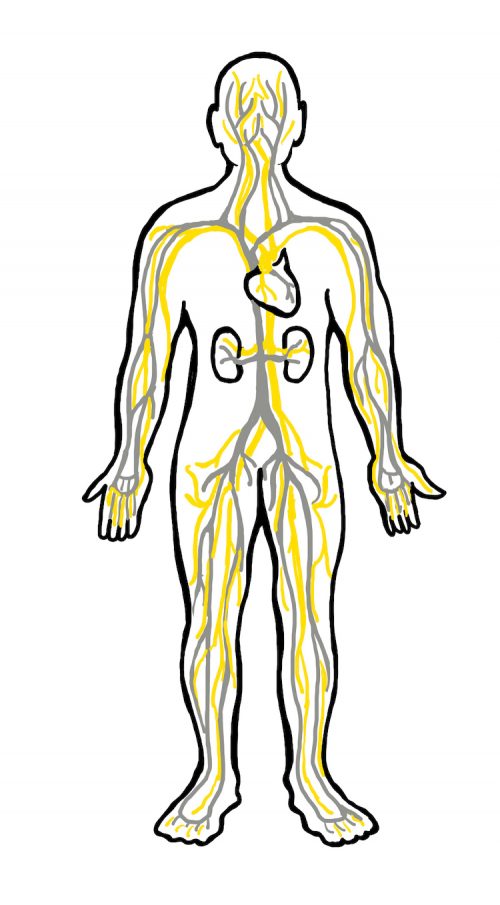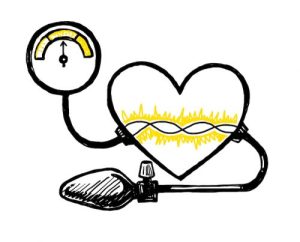An Everyday DNA blog article
Written by: Sarah Sharman, PhD
Illustrated by: Cathleen Shaw
Thanks to Valentine’s Day and American Heart Month, heart symbols are everywhere in February. The heart we all love sending to our sweetheart in text messages looks pretty different than the heart currently pumping within our chests. The origins of the heart symbol are unknown. Some theories claim the heart shape comes from the leaves of a valuable ancient Roman plant. Others believe that St. Valentine used the symbol when arranging secret marriages.

Regardless of its origins, the heart symbol has long been synonymous with love. The anatomical heart, on the other hand, is synonymous with life, providing our bodies with oxygen and nutrients necessary to keep us alive. When things go awry with our hearts or other members of the cardiovascular system, it can have big implications for our health. Let’s learn more about the heart, diseases of the heart and cardiovascular system, and the role genetics plays in the development and prevention of heart disease.
What is the cardiovascular system?
 Your heart is an integral member of the cardiovascular system. The whole system is responsible for moving blood throughout the body, keeping your organs, muscles, and tissues healthy by providing them with oxygen, nutrients, and hormones, and removing waste products like carbon dioxide.
Your heart is an integral member of the cardiovascular system. The whole system is responsible for moving blood throughout the body, keeping your organs, muscles, and tissues healthy by providing them with oxygen, nutrients, and hormones, and removing waste products like carbon dioxide.
The heart is the muscle behind the operation, providing the force necessary to pump blood to tissues throughout your body. Normally, an adult’s heart beats about 60 to 100 times per minute (heart rate), pumping about 5 liters of blood every minute (cardiac output).
Besides your heart, the cardiovascular system also consists of closed vessels called arteries, veins, and capillaries. Arteries carry oxygenated blood away from the heart to the rest of your body. Veins return oxygen-depleted blood to your heart. Capillaries are the smallest and most numerous blood vessels in the circulatory system. They have thin walls that allow oxygen, carbon dioxide, nutrients, and waste products to pass into and out of cells. Capillaries also connect the arterial system to the venous system, completing the closed circulatory system.
So, how do the parts of the circulatory system work together to oxygenate our tissues and remove waste products? The heart pumps blood to the lungs to pick up inhaled oxygen from capillaries near air sacs. Hemoglobin, a protein in red blood cells mostly responsible for oxygen transport, binds oxygen to carry it to other tissues. After returning briefly to the heart, the blood is pumped to the rest of the body through arteries. When the red blood cells reach the tissue that needs oxygen, the oxygen is released from the hemoglobin and diffuses into the cells, where it is used to make energy.
Red blood cells also pick up waste products, like carbon dioxide, and help get rid of them. In the case of carbon dioxide, deoxygenated red blood cells carrying carbon dioxide are returned to the lungs by veins. Carbon dioxide is released from the blood into the air sacs to be breathed out. Air is breathed in, oxygen is picked up by the blood, and the journey begins again.
The heart has its own electrical system that tells it when to contract and relax, which is crucial for making sure the heart beats in a coordinated way, pumping blood efficiently to deliver oxygen and nutrients throughout the body. It’s like the control system that keeps the heart’s pumping rhythm in sync with the body’s needs. If there are any issues with this electrical system, it can lead to heart rhythm problems or other cardiovascular issues.
What are cardiovascular diseases?
Disruptions to the normal functioning of the intricate machinery of the cardiovascular system can lead to profound health implications. Cardiovascular diseases encompass a spectrum of disorders that affect the heart and blood vessels, posing a significant threat to human health. They are the leading cause of death worldwide, with conditions such as heart attacks and strokes being major contributors.
Some of the most common cardiovascular problems include narrowed or blocked arteries supplying the heart (coronary artery disease), a heart that doesn’t pump blood effectively (heart failure), and a problem where the blood flow to the brain is interrupted (stroke). High blood pressure (hypertension), irregular heart rhythms (arrhythmia), and narrow arteries in other parts of the body (peripheral artery disease) also pose risks to cardiovascular health.

Several factors can raise your risk of developing cardiovascular disease. Some you have control over, and some you do not. The main factors beyond our control include older age and a family history of cardiovascular disease. Aging can lead to changes in the heart and blood vessels, making them more susceptible to conditions like atherosclerosis.
Lifestyle choices play a crucial role in cardiovascular disease risk. Eating a balanced diet, staying physically active, getting enough sleep, managing stress, avoiding tobacco, and limiting alcohol intake can significantly reduce the risk of heart disease. Making positive changes in lifestyle habits can lead to a healthier heart and overall well-being.
What role does genetics play in cardiovascular disease?
Genetic factors also play a significant role in cardiovascular diseases. Our genes, which we inherit from our parents, contain instructions for the structure and function of our hearts, blood vessels, and other cardiovascular system components.
Some cardiovascular diseases are linked to genetic factors. For example, certain variations in our DNA can affect how the heart and blood vessels work, increasing the risk of developing conditions like high blood pressure, coronary artery disease, or heart rhythm disorders.
Some conditions, like high blood pressure or coronary artery disease, run in families but probably result from a combination of different genetic changes that work together in a complex manner to cause disease. Other less common inherited cardiovascular diseases are caused by just one or very few genetic changes that have a strong effect in causing disease.
 For single-gene diseases, doctors can use a tool called genetic testing to help identify the cause of an individual’s cardiovascular symptoms. The following inherited cardiovascular conditions can be identified with genetic testing: cardiomyopathies, arrhythmic disorders, thoracic aortic aneurysms and dissections, and familial hypercholesterolemia.
For single-gene diseases, doctors can use a tool called genetic testing to help identify the cause of an individual’s cardiovascular symptoms. The following inherited cardiovascular conditions can be identified with genetic testing: cardiomyopathies, arrhythmic disorders, thoracic aortic aneurysms and dissections, and familial hypercholesterolemia.
Genetic testing can identify specific genetic changes associated with various heart diseases, even before symptoms appear. This allows physicians to proactively monitor the condition and recommend lifestyle changes or medications that could potentially slow its progression. It can also help determine an individual’s inherited risk of developing heart disease. If a person has a family history of a particular heart condition, genetic testing can provide insight into their likelihood of developing the disease.
Prior to recommending genetic testing, your physician will thoroughly examine your family health history, clinical symptoms, and medical records, searching for disease patterns or notable symptoms. If advised for genetic testing, you may meet with a genetic counselor who will further analyze and interpret your family and medical history, providing insights into the implications of genetic testing.
The Smith Family Clinic for Genomic Medicine, LLC, on the HudsonAlpha Institute for Biotechnology campus, offers disease risk testing for cardiovascular diseases. If you are interested in learning what your genome can tell you about your risk for heart disease, contact the Smith Family Clinic for Genomic Medicine.



